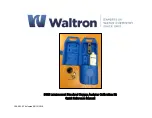
VCS - Viscomaster™
15
Procedure
1. Check that the isolation valves are fully closed.
2. Remove insulation and allow the equipment to cool to a safe level.
Cooling reduces retained pressure.
3. If you have a drain or a pressure-relieving valve, depressurize the system.
4. Slacken the lock nut 1 ½ to 2 turns so that you can rock the sensor.
If necessary, use your hand to jolt the meter loose from the amplifier housing. This breaks the seal between
the sensor and the chamber retrofit kit. Do not slacken the lock nut further unless the seal is broken and the
sensor is obviously loose in the fitting.
NOTE!
If the system is still pressurized, you will be able to lift and hold the meter against the retaining nut.
Rocking and alternately pushing the sensor in and out of the pocket within the limits allowed by
the slackened nut breaks the seal and allows oil under pressure to seep past the lock nut. If this
leakage is excessive, re-tighten the lock nut and take further action to depressurize the system.
5.
CAUTION
Keep all parts of your body away from the direction in which you will remove the sensor. Pressure
caused by a valve failure or a poorly placed lock nut can eject the instrument from the flow chamber
and cause serious injury.
6. Retrofit the meter per the following diagram.
Summary of Contents for Viscomaster
Page 35: ...VCS Viscomaster 35 ...
Page 36: ...36 VCS Viscomaster ...
Page 37: ...VCS Viscomaster 37 For connection with external power supply controller and sensor passive ...
Page 38: ...38 VCS Viscomaster ...
Page 39: ...VCS Viscomaster 39 ...
Page 47: ...VCS Viscomaster 47 ...
















































